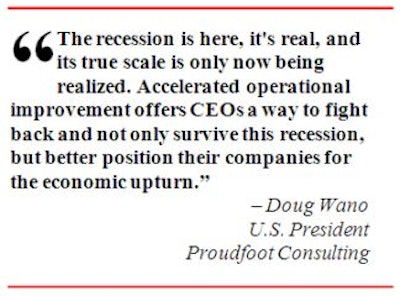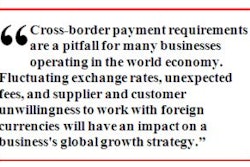
March 12, 2009 — Facing the most destructive economic climate in decades, America's C-level executives are using a variety of standard-issue business strategies to steer their companies through the recession. Some have immediately turned to layoffs to reduce costs, some are trying to restructure debt, and others are utilizing pay cuts and hiring freezes to keep their businesses afloat.
Many, however, are unable to take decisive action, hampered by panicked shareholders and board members. One CEO was recently heard to say, "We're all looking at this huge tsunami heading straight for us, and it's so big and moving so fast that their attitude is 'There's no point even putting on waders.'"
Yet in the midst of all these actions and reactions, there is one management tool that many CEOs have overlooked during this financial crisis: operational improvement.
In essence, operational improvement (or process reengineering) is an activity that intensively focuses on the processes and systems of a business (production, supply chain, sales, cost control and capital expenditures) to examine opportunities for removing those elements that do not add value, or ones that create unnecessary cost. It isn't about strategy, capital expenditure or IT; it's about the human element of business processes and their improvement.
The benefits of such reengineering efforts are immediately apparent: wasted activity is reduced, productivity is increased, employee performance is enhanced. But, most importantly, the process releases working capital and can drastically improve a company's EBITDA figures.
The Need for Speed
This concept is well established in the Total Quality Movement from the 1990s and in current methodologies such as Lean, Kaizen and Six Sigma. CEOs usually hire firms of management consultants to help them develop such a program. More ambitious chief executives form internal "operational excellence" teams in an attempt to drive operational improvements using their own people.
So why is such a proven business improvement methodology being overlooked now?
According to Doug Wano, U.S. president of Proudfoot Consulting, the conventional forms of process improvement programs all lack one crucial element for being able to help a business survive the recession — speed of installation. "The problem is," says Wano, "CEOs can't afford to wait around for two years until the company's operational excellence program delivers the tangible cost savings it promised. They need operational improvements to deliver P&L results now!"
So how does a CEO add speed to process improvement programs? What's the missing ingredient? Wano continues: "The secret is in the execution. CEOs need to hire consultants who have a proven track record of frontline implementation of the process improvements they recommend. It isn't enough to write a big report recommending a list of business improvements, then walking away. Successful and accelerated process improvement only happens when the consultant sticks around to work side-by-side with the workers to embed the new behaviors. That's a pretty rare skills set. Not many consultancy firms can deliver on that requirement."
Wano adds that companies can release working capital and enhance their EBITDA within three to four months using this intensely focused approach to process improvement.
Utilizing process improvements as a tool to release working capital and improve productivity is a concept echoed by Jerry Jasinowski, former CEO of the National Association of Manufacturers. Jasinowski says: "Protection of the balance sheet by focusing on cash requires firms to reduce working capital and cut back on excess inventories quickly and dramatically. It's kind of a bridge to the process improvement points. Difficult economic times provide an opportunity for accelerating process improvement activities."
Bottom Line for CEOs?
Get back to basics by taking a deep dive through every aspect of your business operations: sales, marketing, customer service, supply chain, manufacturing, transportation and energy usage. Bring in a specialist, either internal or through the services of an operational consulting firm. Listen to what they say and take a long, hard look at the potential financial and productivity benefits they present.
But don't "green-light" the project until the consultants can prove that they are going to put "boots on the ground" and work alongside your frontline supervisors and employees day after day to embed the behavioral change necessary to deliver sustainable process improvement. And they need to show that their implementation will accelerate the delivery of real financial benefits in months, not years.
Concludes Wano: "That accelerated pace of delivery is now more crucial than ever. The recession is here, it's real, and its true scale is only now being realized. CEOs must choose to act, and choose a course of action that brings real cash benefits in the shortest possible time. Accelerated operational improvement offers CEOs a way to fight back and not only survive this recession, but better position their companies for the economic upturn."
Many, however, are unable to take decisive action, hampered by panicked shareholders and board members. One CEO was recently heard to say, "We're all looking at this huge tsunami heading straight for us, and it's so big and moving so fast that their attitude is 'There's no point even putting on waders.'"
Yet in the midst of all these actions and reactions, there is one management tool that many CEOs have overlooked during this financial crisis: operational improvement.
In essence, operational improvement (or process reengineering) is an activity that intensively focuses on the processes and systems of a business (production, supply chain, sales, cost control and capital expenditures) to examine opportunities for removing those elements that do not add value, or ones that create unnecessary cost. It isn't about strategy, capital expenditure or IT; it's about the human element of business processes and their improvement.
The benefits of such reengineering efforts are immediately apparent: wasted activity is reduced, productivity is increased, employee performance is enhanced. But, most importantly, the process releases working capital and can drastically improve a company's EBITDA figures.
The Need for Speed
This concept is well established in the Total Quality Movement from the 1990s and in current methodologies such as Lean, Kaizen and Six Sigma. CEOs usually hire firms of management consultants to help them develop such a program. More ambitious chief executives form internal "operational excellence" teams in an attempt to drive operational improvements using their own people.
So why is such a proven business improvement methodology being overlooked now?
According to Doug Wano, U.S. president of Proudfoot Consulting, the conventional forms of process improvement programs all lack one crucial element for being able to help a business survive the recession — speed of installation. "The problem is," says Wano, "CEOs can't afford to wait around for two years until the company's operational excellence program delivers the tangible cost savings it promised. They need operational improvements to deliver P&L results now!"
So how does a CEO add speed to process improvement programs? What's the missing ingredient? Wano continues: "The secret is in the execution. CEOs need to hire consultants who have a proven track record of frontline implementation of the process improvements they recommend. It isn't enough to write a big report recommending a list of business improvements, then walking away. Successful and accelerated process improvement only happens when the consultant sticks around to work side-by-side with the workers to embed the new behaviors. That's a pretty rare skills set. Not many consultancy firms can deliver on that requirement."
Wano adds that companies can release working capital and enhance their EBITDA within three to four months using this intensely focused approach to process improvement.
Utilizing process improvements as a tool to release working capital and improve productivity is a concept echoed by Jerry Jasinowski, former CEO of the National Association of Manufacturers. Jasinowski says: "Protection of the balance sheet by focusing on cash requires firms to reduce working capital and cut back on excess inventories quickly and dramatically. It's kind of a bridge to the process improvement points. Difficult economic times provide an opportunity for accelerating process improvement activities."
Bottom Line for CEOs?
Get back to basics by taking a deep dive through every aspect of your business operations: sales, marketing, customer service, supply chain, manufacturing, transportation and energy usage. Bring in a specialist, either internal or through the services of an operational consulting firm. Listen to what they say and take a long, hard look at the potential financial and productivity benefits they present.
But don't "green-light" the project until the consultants can prove that they are going to put "boots on the ground" and work alongside your frontline supervisors and employees day after day to embed the behavioral change necessary to deliver sustainable process improvement. And they need to show that their implementation will accelerate the delivery of real financial benefits in months, not years.
Concludes Wano: "That accelerated pace of delivery is now more crucial than ever. The recession is here, it's real, and its true scale is only now being realized. CEOs must choose to act, and choose a course of action that brings real cash benefits in the shortest possible time. Accelerated operational improvement offers CEOs a way to fight back and not only survive this recession, but better position their companies for the economic upturn."











